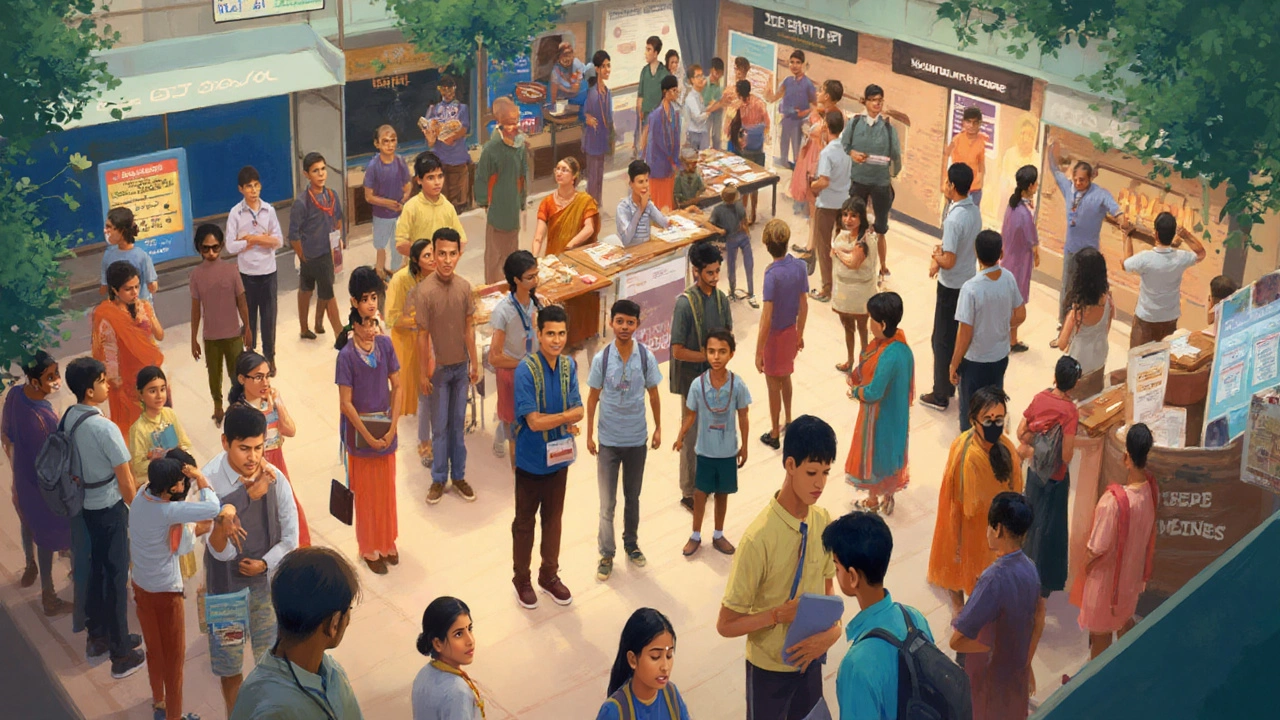Every year, over a million students jump into the crazy grind called JEE. The number of seats in IITs? Just over 16,000. The odds feel like playing cricket with a toothpick as a bat, but the right school can give you a real edge. Think about it: a good school isn’t just about teachers and marksheets. It’s about how smoothly you juggle boards and JEE, how you handle stress, how inspiring your classmates are. With new schools and institutes popping up faster than chai stalls near exam centers, how do you figure out which school will actually make a difference? Not every school with ‘IIT’ in big letters on its gate is worth your sleepless nights (or your parents’ cash). If someone tells you there’s a golden list—‘just go to XYZ and you’ll be set’—they’re bluffing. The real answer needs a closer look.
What Makes a School Stand Out for JEE?
First things first, let’s bust a classic myth: No school alone will guarantee an IIT seat. Most toppers swear by a mix—good schooling, extra coaching, self-study, and lots of revision stumbles. But schools matter, big time. The best ones do a few things really well. They carve time out of the board-exam madness for you to dive deep into JEE-level math and physics. Real teachers, not just videos or PDFs from a faceless app, sit with you graphing parabolas or untangling electromagnetism. They keep the pressure on without pushing you off the edge—regular tests, doubt-clearing sessions, peer groups that challenge you in a good way.
Look at Hyderabad Public School, Narayana, Sri Chaitanya, Kota’s Allen (which has now partnered with formal schools), and Delhi’s Delhi Public School RK Puram. These aren’t just famous names thrown around in coaching ads. Their results are out there for everyone to see. Narayana and Sri Chaitanya, especially in Telangana and Andhra Pradesh, are like JEE assembly lines, sending hundreds to the IITs yearly. Allen Integrated in Kota and some Delhi Public School branches have figured out the balancing act—integrated curriculums where board and JEE go under one umbrella. Why does that matter? Because the last thing you want is to play ping-pong between boards and JEE, wearing yourself out on two test patterns at once. An integrated setup means less travel, less stress, and one set of mentors who know your pace and weaknesses.
But let’s get real—every school claims to have ‘top faculty’ and the ‘best system’. What should you look for? Check faculty backgrounds—are they ex-IITians or at least solid, experienced teachers? Ask around (forums like Quora, Reddit, even Instagram DMs to ex-students work better than polished brochures). Next, class size—more than 50 per batch? You’re a roll number, not a person. Look for schools where batch sizes are under 40 for science sections. Here, you won’t get lost in the crowd. Regular mock tests (weekly/biweekly), on-the-spot doubt-clearing, and a habit of publishing actual JEE result stats rather than percentages—that’s a healthy sign. And yes, facilities matter too. Late library hours, quiet study corners, on-campus counseling, smart digital labs—all these help when you’re neck-deep in practice papers and the panic starts rising.
Here’s a snapshot from the 2025 JEE results:
| School/Institute | State | No. of IIT Selections (2025) | Average Batch Size |
|---|---|---|---|
| Narayana Junior College | Telangana | 830 | 35 |
| Sri Chaitanya | Andhra Pradesh | 785 | 37 |
| Allen Integrated Program | Rajasthan | 670 | 40 |
| Delhi Public School RK Puram | Delhi | 158 | 38 |
| Resonance School | Rajasthan | 140 | 42 |
Of course, these are big numbers. But remember, smaller schools in towns like Kota, Kanpur, Patna, and Indore also have hidden gems—teachers with cult followings and peer groups that quietly send kids to IIT every year.

Comparing Popular Schools and Coaching-Integrated Programs
Now this is where it gets juicy—should you jump into a famous school with its own in-house coaching, or keep school and coaching separate? Here’s what’s happening on the ground. Integrated programs have exploded, especially in South India and Rajasthan. The big players—Narayana, Sri Chaitanya, Allen Career Institute—run entire schools designed for JEE. Timetables blend NCERT and advanced JEE level topics. Your math teacher on Monday morning is also your math mentor for after-school JEE drills. No double work, no confusion. These setups are famous for their test series—sometimes twice a week—and Solutions Discussions that go way deeper than your board examiner expects. It’s hard, yes, but it gets results. And they’re relentless about performance tracking. If you bomb a test, someone sits you down and analyzes every question you got wrong.
But this comes with pressure. The story of Kota is a warning: the pace can be brutal, the ‘race’ real. Not everyone thrives here, and too many students burn out. That’s why cities like Bangalore, Pune, and Delhi have become havens for students who want a less intense scene. Schools like DPS RK Puram, DAV Public School, and certain Kendriya Vidyalayas now offer ‘JEE cells’ inside the normal schedule, plus partnerships with coaching groups like FIITJEE, Vidyamandir, or Aakash. This hybrid approach works well for students who value a broader high-school experience—sports, festivals, and not just study marathons. In fact, a 2024 survey by Shiksha.com found 47% of JEE qualifiers valued ‘balance between studies and extracurriculars’ the most when picking a school.
Some students choose the ‘hostel+school+coaching’ package to stay focused. Parents figure that if food, classes, and coaching all happen in one building, distractions go away. But here’s a heads-up: this works if you’re self-driven and okay being away from home, eating mess food, and keeping your head down. If you need more personal attention, a day school plus weekend coaching might fit you better. Then there’s online. Since COVID, some of the best schools let students attend specialized live JEE coaching through Zoom/Teams—think of it as a modern twist on tuition. But purely online prep isn’t for everyone—without the buzz of classmates competing and encouraging you, motivation can dip fast.
Certain schools stand tall for not just their results but their approach— Rao IIT Mumbai, FIITJEE World School Hyderabad, Chaitanya Techno School, ALLEN Swami Vivekananda School Kota, Vidyamandir Classes Gurgaon School. Yes, these places do cost more (fees can hit INR 50,000–2,00,000 per year). Scholarships do exist, and don’t shy away from applying, even if you’re not a ‘topper’. For girls, schools like Lady Shri Ram College’s feeder program and R.N. Podar School (which partners with special girl-child JEE cells) have been making real inroads since 2023.
Costs aren’t everything, but they matter. The best schools don’t just charge for ‘brand value’; you’re paying for quality teachers, top test series, mentors who actually care, and, crucially, a support system when the stress starts crushing you. Here’s a simplified comparison:
| School/Program | Fee Range (INR/year) | Integrated JEE Prep? | Doubt Support | Extracurriculars |
|---|---|---|---|---|
| Narayana Junior College | 1,20,000–2,00,000 | Yes | High | Low |
| Allen Integrated Program | 1,00,000–1,80,000 | Yes | High | Low–Medium |
| DPS RK Puram (with FIITJEE) | 90,000–1,50,000 (school); coaching extra | Partially | Medium–High | High |
| Vidyamandir School Gurgaon | 1,70,000–2,20,000 | Yes | High | Medium |
One more thing: location. Kota has hostel life, Hyderabad and Secunderabad are great if you hate the north’s climate, Delhi’s cosmopolitan—pick what fits your style. Board results matter too. Integrated schools help you prep for state or CBSE boards alongside JEE, but if you’re brilliant at self-study and want more freedom, you might be better off in a normal school and doing coaching on your own. Some CBSE schools still have strict attendance rules that clash with JEE prep—you’ll need to check.

Insider Tips for Picking the Right School for Your JEE Dream
If you’re reading all this and feeling overwhelmed, hey, welcome to the club. No single school can make you IIT-ready if you aren’t in the game. But the right school creates the environment, discipline, and spark to hustle harder. Here’s what you can actually do:
- Start with your learning style. Do you need deadlines and a real teacher nagging you? Or do you like independent study with Zoom sessions for doubts?
- Visit the top 2-3 schools/coaching combos you’re thinking about. Don’t just read reviews—check classrooms, talk to students, see if the energy feels right.
- Ask for the last three years’ actual JEE result lists (with roll numbers, not just shiny numbers). If a school hesitates, that’s a red flag.
- Check class size. Under 40 is best. Smaller means you can ask more questions and get personal attention.
- Look at regular test schedules and feedback. Consistent, tough mock tests mean your teachers take the competition seriously.
- Balance matters. You’ll need exercise, sleep, good food, and chances for a breather—especially important during those weeks when nothing seems to stick in your brain. Schools that encourage even one sport or hobby on weekends are miles ahead for mental health.
- Check if the school has experienced counselors or mental health support. The JEE journey is a marathon. You’ll be surprised how much talking to someone helps during rough patches.
- Don’t ignore location. Long commute? Bad hostel food? Can’t find peace to study? These little things pile up and can wreck your focus.
- Ask about scholarships and fee waivers. Good schools want the results, not just the money, and they offer solid merit-based discounts or even need-based help if you ask early.
- Most schools have started offering demo classes—jump into one before deciding. Don’t just trust glossy prospectuses.
The gold standard isn’t just about cracking JEE. It’s whether your school builds a routine, gives honest feedback, and backs you when you go through the stress rollercoaster. Every year, thousands who aim for IIT end up finding new strengths within themselves, or sometimes shifting plans to other top engineering colleges—they still look back and thank their school for giving them the space and push.
The *best school for JEE* is the one that fits your mindset, pushes you honestly, balances pressure and support, and helps you grow beyond marks. Sometimes, that’s a big-name school, sometimes it’s a lesser-known but tight-knit academy in your own city. Don’t let the hype machine or distant relatives decide. Trust your research, visit, ask around, check facts, and then jump in. Your JEE journey is about much more than just getting into IIT—it shapes how you tackle every tough challenge from here on.
